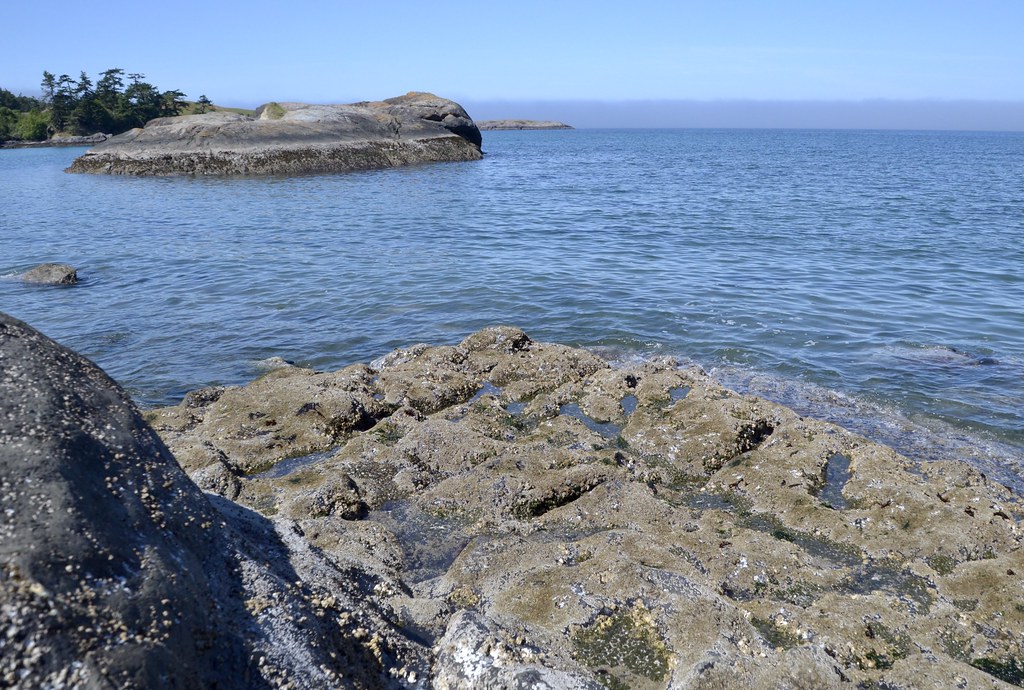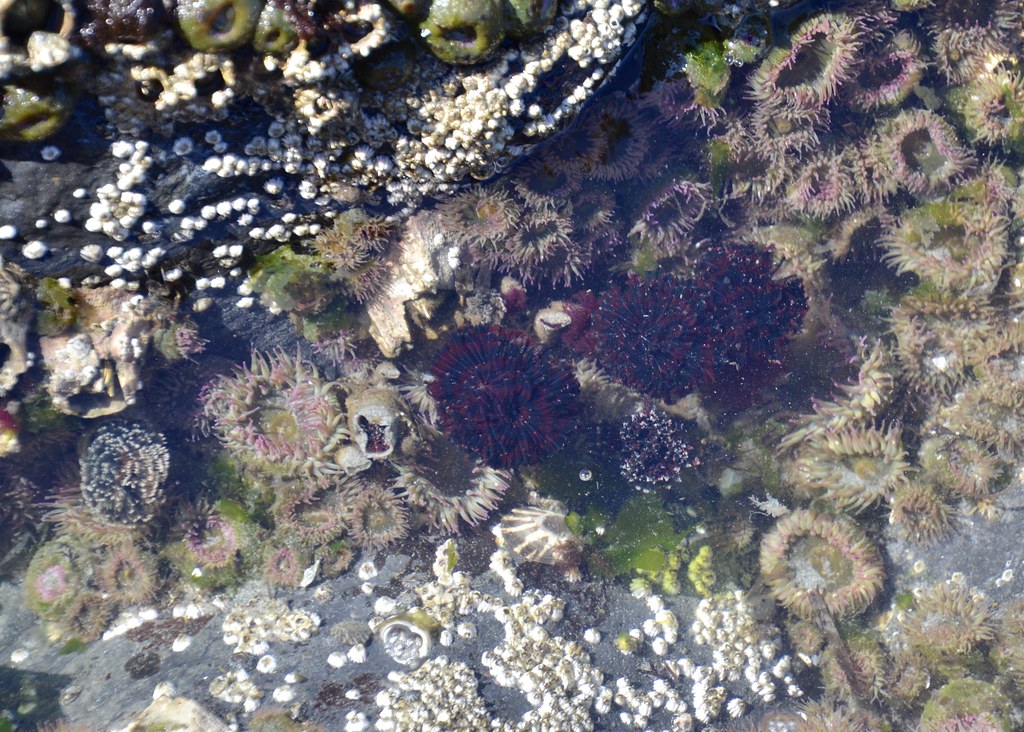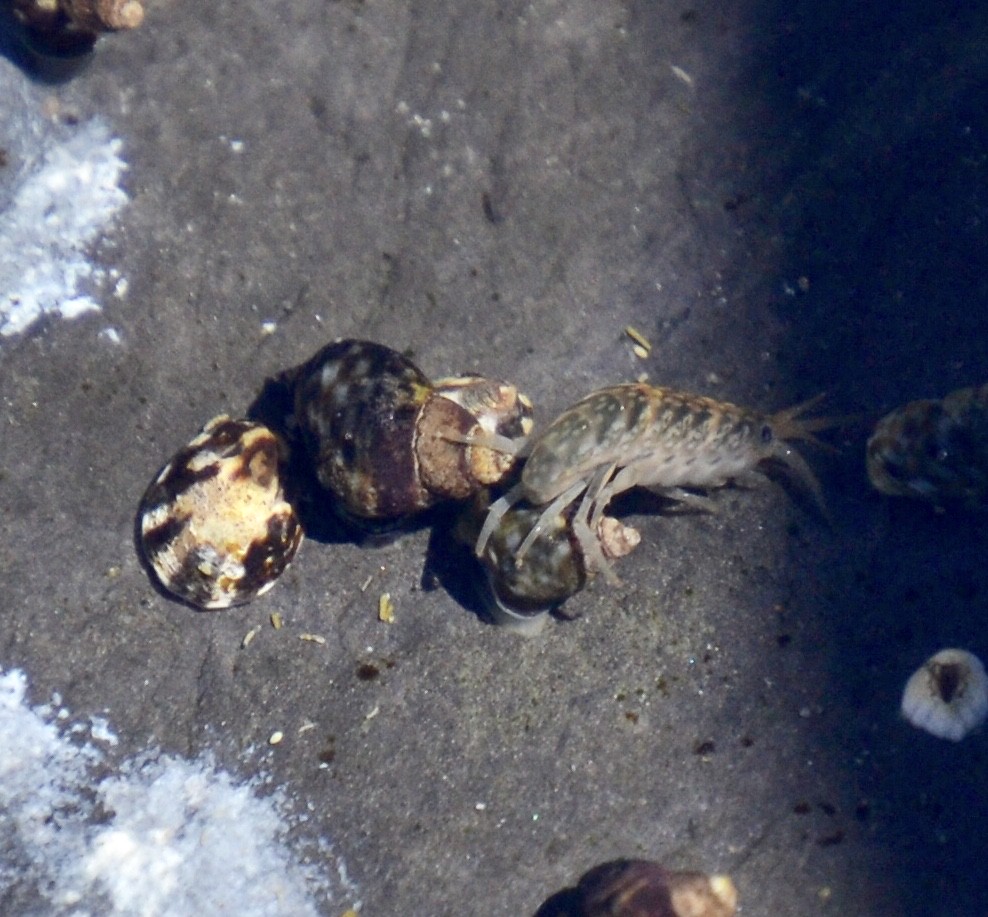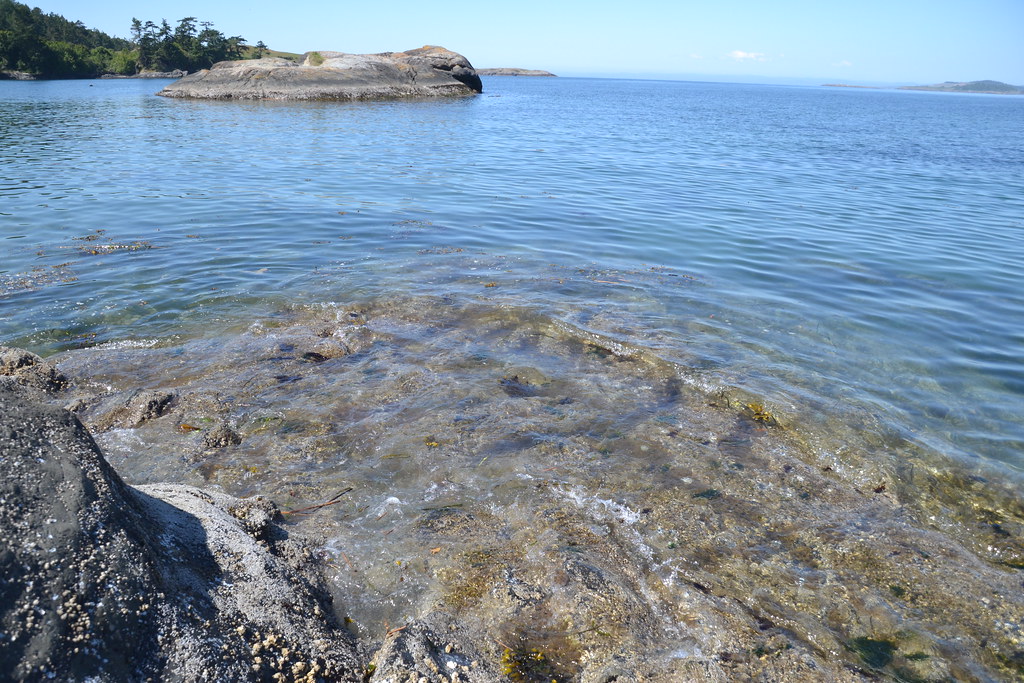|
The Daily Bucket is a nature refuge.
We amicably discuss animals, weather, climate, soil, plants, waters and note life’s patterns.
We invite you to note what you are seeing around you in your own part of the world, and to share your observations in the comments below.
|
.
May 23, 2019
Salish Sea, Pacific Northwest
I went down onto one of our more exposed shorelines the other day to check out Rough-winged swallow burrows in the clay bluff (there were a few, looking active) and while there, sat for a bit on a rocky section at the water’s edge. I do very little exploring of our intertidal zones these days as I’m very fearful of falling, and that’s a real possibility with the unstable footing and slippery seaweed of the zone between high and low tide. Plus I’m so creaky these days, it’s hard for me to crouch down to see the small critters who live in the tidepools and crevices.
 Looks so peaceful doesn’t it.
Looks so peaceful doesn’t it.
Nevertheless, on this occasion the small rocky patch high up in the intertidal was fairly flat and not too slippery, so I spent some time checking out how lively the marine life was there. Generally speaking, the lower intertidal zone is far more densely packed with life because it’s under water most of the time, and aquatic creatures require water. Exposed to air, critters are not only at risk of drying out but they also have less access to food. It’s a very harsh life, choosing to live high up in the intertidal zone as the refreshing water drains away, and the few who populate that marginally marine world rely on all kinds of adaptations to survive there.
Tide pools are little pockets of more favorable conditions, where a small quantity of seawater helps keep critters moist. They are very popular, packed wall to wall. But even there the water gets inhospitable quickly: floating food particles are quickly depleted, and depending on the weather, the water gets too warm, or it freezes, or it gets too salty or too fresh, or maybe a combination of those. Not to mention getting pounded by waves and driftwood. You gotta be tough living in a tide pool.
It looks so peaceful along the shore at low tide. Isn’t so much for the marine creatures who live there.
Who lives on this rocky platform?
Aggregating anemones prefer to tuck into crevices where they don’t get too thrashed by surf. You can tell at a glance which are open by their color. Green is closed, pink is open. Given any opportunity to eat, anemones will expose their pink tentacles to snatch passing food particles. The tide pool below is still receiving some wave swash, until the tide goes down more. Around it the anemones have closed up shop for the next 6-8 hours.
 The bedrock is grey. Most every square inch is covered with small animals.
The bedrock is grey. Most every square inch is covered with small animals.
 A few more minutes of feeding. These anemones are all clones of each other. While they can reproduce sexually, they can also split in two over and over forming a large mat of genetically identical anemones. If two groups meet up they “fight”, creating a “zone of repugnance” between the sets of anemones.
A few more minutes of feeding. These anemones are all clones of each other. While they can reproduce sexually, they can also split in two over and over forming a large mat of genetically identical anemones. If two groups meet up they “fight”, creating a “zone of repugnance” between the sets of anemones.
 These are closed up until the tide comes back up. They have coated themselves with mucus which protects their reservoir of moisture inside. Sometimes people step on them, finding amusement in how they squirt water. That can be a death sentence for those anemones.
These are closed up until the tide comes back up. They have coated themselves with mucus which protects their reservoir of moisture inside. Sometimes people step on them, finding amusement in how they squirt water. That can be a death sentence for those anemones.
There were a few tubeworms in some of the tidepools. The striped maroon and black fluffy clumps are the feeding tentacles of these Feather Duster worms, their bodies protected by a leathery tube. To the left of the feeding tubeworms are a few with tentacles withdrawn.
 Tubeworms and anemones parked in a tide pool
Tubeworms and anemones parked in a tide pool
There’s actually quite a lot of activity in a tidepool. This short video below gives you a sense of that.
The quickest-moving animals there are the amphipods (look sort of like shrimp), crawling in and around barnacle houses searching for edible detritus.
Almost as fast moving are the barnacles (yellowish) in feeding mode. In the presence of water they’ll open their doors up top and sweep the water with their feet. These are looking a bit half-hearted. The water is shallow and warming up. They’ll close up soon, lock their doors and wait for the tide to come back up.
The tiny black and white patterned snails there roam more slowly than the arthropods, lacking the leverage of a skeleton. They are feeding on the algae that is thinly coating the barnacles (which are otherwise white). These are periwinkles (inverts.wallawalla.edu/...) who live as high in the intertidal as possible to avoid their predators, mostly aquatic carnivores like small fish, whelks, some seastars, and diving ducks. To survive many hours exposed to dry air and changes in temperature — even days or weeks — periwinkles have ways to keep their body moist. When the tide goes down, they close the opening to their spiral with a custom-shaped door and secrete a mucus that glues them to the rock. In extreme conditions of heat or cold, they can James Bond to safety by detaching and rolling downward, hopefully into water. Cool, huh? If all that wasn’t impressive enough, periwinkles can also survive in water that is saltier and fresher than the ocean: tide pools not refreshed frequently by the tide can evaporate or get rained on, radically changing the salinity.
Periwinkles are small but mighty. One study measured the grinding power of their sandpaper-like mouthparts as able to scrape off a centimeter of rock over 16 years!
 Limpet, periwinkles, amphipod
Limpet, periwinkles, amphipod
Limpets are another well-adapted high-intertidal invertebrate. Like snails, they are gastropods, a kind of mollusk with a coiled shell. In limpets the coil is very flat, leaving a large opening filled with a large sucker-like foot. In good hunting conditions, usually at night, limpets wander around the upper intertidal grazing, but then return to their “home”, a shallow depression on the rock they have carved out over time that just fits their shell (www.skagitbeaches.org/….). Limpets adhere so well to flat surfaces that if you try to lever them off, they will break before letting go. Limpet-feeders like oystercatchers are masters at surprising them before they have a chance to latch on securely.
I see at least three kinds of limpets in this tide pool. Each species has slightly different habitat preferences. Some handle surf better, some heat. This page (soundwaterstewards.org/...) has a nice comparison of our local limpets.
 Barnacles, periwinkles and several kinds of limpets.
Barnacles, periwinkles and several kinds of limpets.
A return visit on May 27 at a somewhat higher tide shows the ledge with the anemones and tubeworms fully covered. Barnacles, periwinkles, limpets and amphipods are still exposed to air.
 Platform awash. Anemones are all open for business.
Platform awash. Anemones are all open for business.
It was fun to catch up with old friends in tidepools. The diversity is low this high up in the intertidal zone but the adaptations of these invertebrates are formidable, dealing with extreme environmental conditions. I can’t help but muse upon the changes we might see in our marine life here as the ocean warms or there are sudden habitat changes. I suspect that it’s creatures like these who will be most likely to survive and thrive, while more sensitive animals fall by the wayside. The Seastar Wasting Syndrome epidemic a few years ago is an example of that sensitivity; a disease triggered by warmer waters decimated most kinds of seastars along the West Coast. Seastars, like all echinoderms, are creatures who require the near constant submersion of the lower intertidal zone. Those ecosystems have still not recovered. Meanwhile the humble barnacles, periwinkles, limpets and anemones busy themselves successfully up in the high intertidal.
🌿
Early overcast in the PNW today, becoming sunny later. Temps cooler, 60s in the daytime, 50s at night. Seeing some high haze, likely smoke from that massive wildfire in Alberta, Canada.
What’s the nature news in your neighborhood?
🌿
|
"SPOTLIGHT ON GREEN NEWS & VIEWS"
EVERY SATURDAY AT 3:00 PM PACIFIC TIME ON THE DAILY KOS FRONT PAGE.
IT'S A GREAT WAY TO CATCH UP ON DIARIES YOU MIGHT HAVE MISSED. BE SURE TO RECOMMEND AND COMMENT IN THE DIARY.
|
|


